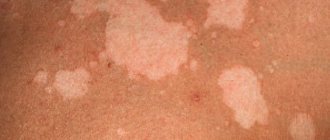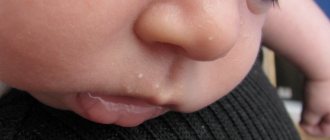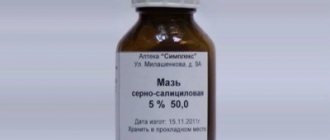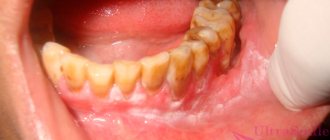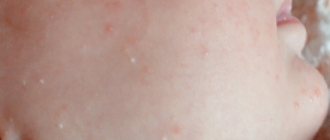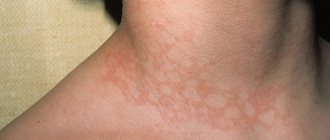White spots on the skin of children – vitiligo, pityriasis alba
Authors : Christophe HSU, Global Dermatology Information Portal
Typical causes of white spots on the skin of children are: 1) Pityriasis alba 2) Vitiligo
What is “Pityriasis alba”?
- Pityriasis alba is a mild form of dermatitis (skin inflammation).
- This condition is characterized by the appearance of numerous oval, slightly scaly, smooth, hypopigmented (white) patches on the face, arms, and upper torso.
- The boundaries of these spots are unclear.
- The disease occurs in children aged 3 to 16 years; about 30% of children at this age may be susceptible to this disease.
- The spots are not accompanied by itching.
- This disease is often mistaken for a fungal infection (mycosis).
- The condition tends to worsen with exposure to sunlight.
Treatment of pityriasis alba and preventive measures
- This disease is safe. It occurs in cases of hereditary predisposition or against the background of atopic dermatitis. The treatment essentially involves moisturizing the skin.
- The disease can last from several months to several years with a slow spontaneous recovery process.
- Sometimes steroid creams can improve the condition.
- Do not self-medicate.
- Avoid using antifungal creams.
- Limit the use of soap when washing your skin and use detergents that do not contain irritants.
What is vitiligo?
- Vitiligo is the loss of skin pigmentation in certain areas of the skin. These areas of skin appear as smooth white spots with clear contours. The hair in the area of vitiligo spots is often also white.
- There are two types of vitiligo:
- Type A: Vitiligo appears as numerous white patches, widespread and symmetrical. This type of vitiligo most often affects areas of the body such as the limbs, face and neck.
- Type B: Vitiligo appears as localized patches of segmental distribution. This type of vitiligo is most common among children.
- Vitiligo type A tends to spread to other areas of the skin, forming new lesions over time.
- Vitiligo type B tends to spread rapidly and then stop progressing after about one year.
- The causes of vitiligo are not fully known. Among people suffering from vitiligo, the most common cases are diabetes mellitus and thyroid disease.
How is vitiligo treated?
- Your doctor may prescribe one or more of the treatments listed below:
- Topical steroid creams. This method may promote skin repigmentation in some patients.
- PUVA (psoralen + ultraviolet A) is a combination treatment that involves using the drug Psoralen (P) and then exposing the skin to ultraviolet A (UVA). Psoralen can be applied to the skin as a lotion or taken orally in tablet form to increase the skin's sensitivity to ultraviolet rays. Patients undergoing PUVA treatment should be aware that the duration of therapy may be more than a year to achieve optimal results. It is best if this treatment is carried out under the supervision of a dermatologist.
- Concealing cosmetics. Using some cosmetics, you can choose a color that most closely matches your natural skin color. Concealing cosmetics are found to be effective in covering up white spots on the face and back of the hands.
- Sunscreens. Areas of skin affected by vitiligo are prone to sunburn. It is recommended to use sunscreen on affected areas exposed to sunlight.
- Response to treatment may vary across different affected areas of the skin and may vary between patients.
Source
Diagnosis of pityriasis
If you find suspicious spots on the skin, you should promptly contact a dermatologist. During a visual examination, the doctor assesses the nature of the rashes, their shape, size, location on the body and is able to make the correct diagnosis. After dermatoscopy, the following studies are additionally carried out: biochemical tests of blood and urine, RMP (microprecipitation reactions with antigens), skin scrapings from injured areas.
A more complex diagnosis is carried out if the skin disease lasts more than six weeks. In these cases, discharge from the affected lesions is sent for bacterial culture. A biopsy and subsequent histological studies will help make the correct diagnosis. In order to distinguish Zhiber's disease from other types of lichen, toxicerma, psoriasis, complicated syphilis and other pathologies, fluorescent diagnostics are carried out, scrapings are checked for the presence of pathogenic fungi, RPR tests are done for syphilis, etc.
Prevention
Following a number of rules will help prevent the disease:
- Always treat cuts and injuries with an antiseptic, even minor ones. Microbes and viruses look for every opportunity to enter the body, especially if it is weakened.
- Follow the rules of personal hygiene - do not use other people's combs, washcloths and other things.
- Monitor the state of your immune system and prevent it from becoming depleted. Best friends in this case: proper nutrition and exercise.
- Avoid stressful situations and excessive fatigue.
- Include foods that have an antiviral effect in your diet - lemon, onion, garlic. This also includes various herbal infusions, which also have an antimicrobial effect. For example, pour a glass of boiling water over a teaspoon of oregano, lemon balm, chamomile or thyme, let the herb brew for twenty minutes and take half a glass twice a day. This therapy should be carried out no more than twice a week.
Complications and consequences
The disease itself does not pose any danger, except that its course may last for several years. If there are few spots, they do not have a bright, pronounced color and do not cause inconvenience to a person, no measures can be taken to treat them. The only thing to remember: if the immune system is weakened, allergies develop, or excessive exposure to sunlight, a relapse of the disease may occur.
Therefore, if you do not want to ruin your vacation or darken your mood with disrupted plans, then it is better to contact a specialist. Treatment will not take much time, but the spots can make themselves known as pronounced white lesions at any time.
As for complications, if personal hygiene recommendations are not followed, signs of an inflammatory disease may be added to lichen alba, the treatment of which will be more serious.
Pityriasis rosea in pregnant women
Pityriasis occurs more often in women than in men. It is especially dangerous when the skin disease occurs in pregnant women. If you notice any rashes, it is important to immediately visit a dermatologist and undergo treatment. It is unacceptable to risk the baby’s health and expect the plaques to disappear on their own. If the disease is not treated, then bacterial infections appear, which are much more difficult to deal with.
If a pregnant woman has not been diagnosed with pityriasis rosea, it is nevertheless important to adhere to the following recommendations:
- clothing made from cotton and linen is preferable to synthetic and woolen fabrics
- limiting heavy physical activity
- For hygienic purposes, use only warm water
- timely moisturizing of damaged skin areas
Photo of simple white lichen: what it looks like
The photo shows how certain parts of the human body are covered with white spots. These can be either individual foci or entire islands of rashes. With light skin tones, the formations have an inconspicuous appearance. The shape and size of the spots are also varied. The photos also show the flaky surface of the spots with uneven edges.
Varieties and atypical forms
Lichen alba, like vesicular lichen, is a type of simple lichen. Visually, it is similar to multi-colored lichen: the only difference is that the spots with multi-colored rashes do not appear on the face.
Atopic dermatitis is often a secondary disease in lichen alba. There is a relationship between skin diseases and skin injuries.
Lichen alba refers to a slowly progressive disease in which the lesions gradually spread and increase in size.
Based on the nature of the spread of the rash, the following types of white lichen are distinguished:
- segmented, in which formations are concentrated in the area of one skin segment;
- focal, characterized by the merging of several spots into a lesion;
- universal, when the rash spreads throughout the body.
The symptoms are largely similar to other dermatological diseases, so it is often very difficult to make a diagnosis. Peeling of the skin and white spots are also characteristic of such pathologies as vitiligo, pityriasis versicolor, pityriasis versicolor and many other skin diseases. Therefore, to make an accurate diagnosis, it is necessary to know other manifestations characteristic of a particular disease. In any case, the main difference between white lichen and its other forms is not contagiousness.
Sometimes the pathology can occur in an atypical form. This includes atypical localization of spots or irritating lichen associated with friction, injury, sweating and manifested by increased itching.
During pregnancy
Pregnancy is associated with changes in hormonal levels and a weakened immune system, so during this period a woman may be faced with various kinds of previously undetected ailments. Lichen simplex can also be classified in this group. White spots may be the body's reaction to allergens. Perhaps the bacteria were already in the body and simply became active at a certain moment.
Lichen alba does not pose a threat to either the woman or the fetus. The only possible discomfort is itching. And if a woman experiences discomfort, this will affect her emotional state, which, in turn, will affect the child’s condition. Therefore, if inconvenience occurs, you should still get rid of lichen.
There are no contraindications for the treatment of lichen during pregnancy. Perhaps you should hold off on taking herbal teas internally: some herbs have a negative effect. But swimming in warm water will even be useful.
Traditional medicine recipes for the treatment of asbestos pityriasis
Tincture of celandine helps well with pityriasis. This medicine can be bought in pharmacies, or you can prepare it yourself at home.
Several ways to lubricate affected areas of the body
- Celandine in vodka. It is necessary to collect celandine during the flowering period and dry it, fill the jar tightly with it and fill it completely with vodka. Leave the product in a dark place for three weeks, then strain it and fill it halfway with vodka again.
- Water tincture of celandine. Take 1 tbsp. spoon of dried celandine and pour a glass of boiling water. The vessel needs to be covered and left to steep for about 30-40 minutes. After straining, the tincture is ready for use.
A local remedy for skin diseases is a mixture of talc, zinc oxide, water and glycerin. This mixture has a calming effect and disinfects the skin, which has a positive effect on recovery.
To wash areas of skin affected by pityriasis, use the water in which buckwheat porridge was cooked.
The use of compresses made from raw yeast dough, which are applied to the rash, is encouraged.
When itching, it is important not to scratch the affected areas of the skin. Otherwise, the risk of developing an infectious process increases, which will significantly reduce the speed of recovery and threaten complications. To control yourself at night, you can apply bandages to the itchy spots.
You can use apple cider vinegar to relieve itching. Compresses made from a soda solution (1 teaspoon of soda per 1 glass of clean filtered water) and chamomile decoction will also be effective.
Causes
The etiology of the disease has not yet been studied: the pathology refers to dermatitis without a specific course. If we assume that the disease is most often characteristic of adolescence, we can conclude that it is associated with insufficient or excessive personal hygiene. A disturbed balance of the microflora of human skin due to hormonal imbalance can also lead to illness.
There are two fundamental judgments that describe not only the sources of the appearance of pityriasis alba, but also its belonging to any group of pathologies:
- Malassezia. According to this theory, lichen is caused by Malassezia bacteria, which, when entering the body, suppress access to ultraviolet rays to the skin. This yeast-like fungus is a representative of the normal microflora of the skin and can manifest itself in case of any failure in the human immune system. A chemical compound secreted by the fungus affects the movement of melanin. As a result, some areas of the skin become lighter.
- Staphylostreptoderma. According to another, less recognized version, pityriasis alba is classified as a mild form of staphylostreptoderma, an inflammatory skin disease caused by streptococci.
The main group of people most susceptible to this pathology and determining the roots of the development of the disease has also been identified:
- people suffering from frequent allergic rashes or who have suffered an allergic form of dermatitis;
- patients suffering from hay fever, eczema or bronchial asthma.
It is believed that boys from three to sixteen years of age are more susceptible to lichen alba. If the disease makes itself felt in the first years of life, then it can remain on the skin for a long time. In this case, we are talking about a chronic form of pathology. Adults are susceptible to it less often and mainly during periods of weakening of the immune system. There is also an opinion that the disease is more typical for the spring-summer period.



